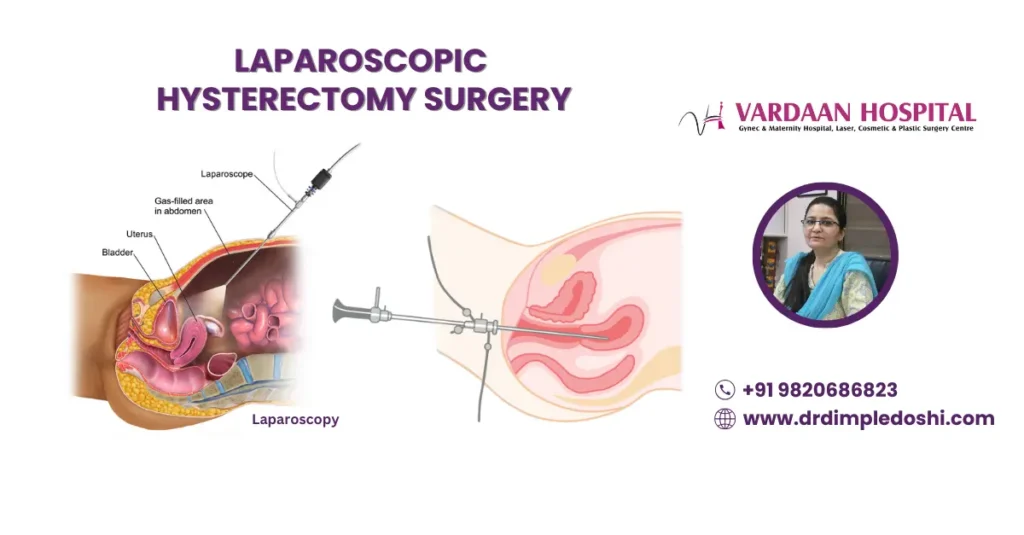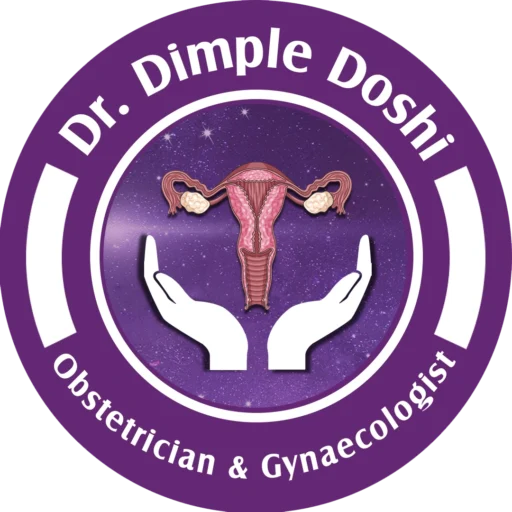
Laparoscopic Hysterectomy: Advanced, Safe & Effective Uterus Removal
Is Chronic Pelvic Pain or Heavy Bleeding Controlling Your Life?
Are you struggling with relentless pelvic pain, heavy periods, or recurring conditions like fibroids and adenomyosis that don’t respond to medications or non-surgical options? Has your quality of life—sleep, intimacy, and emotional well-being—started slipping away?
No woman dreams of parting with her uterus. Yet, when symptoms overpower daily life, a hysterectomy often becomes a medical necessity. The decision is never easy. It’s natural to wonder:
- “Will I lose a part of my identity?”
- “Will it affect how I feel as a woman?”
- “How long will recovery take? Will life return to normal?”
Fears about pain, complications, or even life after surgery can feel paralyzing, leaving you stuck in discomfort while longing for relief.
Solution:
At Vardaan Hospital, we offer a modern, minimally invasive option: 3D Laparoscopic Hysterectomy. This advanced technique uses tiny keyhole incisions and high-definition 3D visualization for unmatched precision. Benefits include:
- Minimal bleeding and scarring
- Shorter hospital stay and faster recovery (walk within hours)
- Less pain and quicker return to normal life
Led by Dr. Dimple Doshi—a leading laparoscopic surgeon with 27+ years of experience and 25,000+ successful surgeries—we ensure safety, dignity, and compassionate care throughout your journey.
You’re Not Alone—And There Is Hope
This isn’t just a surgery—it’s a fresh start. And you deserve to embrace it with confidence, not fear.
What is a Laparoscopic Hysterectomy?
Laparoscopic hysterectomy, also called minimally invasive hysterectomy or keyhole uterus removal surgery, involves removing the uterus using a laparoscope. It offers less pain, minimal scars, and quick recovery compared to open surgery.
- Performed through small keyhole incisions
- Uses advanced 3D laparoscopic camera for precision and safety
- Preferred for faster healing and better cosmetic results
Synonyms: Minimally invasive hysterectomy, keyhole hysterectomy, laparoscopic uterus removal, laparoscopic uterine surgery.
What Are the Common Reasons to Need a Laparoscopic Hysterectomy?
It’s recommended when medical treatment fails or conditions severely impact your health and quality of life.
- Uterine fibroids causing heavy bleeding
- Endometriosis or adenomyosis
- Persistent abnormal uterine bleeding
- Early-stage gynecological cancers
- Chronic pelvic pain
- Uterine prolapse
What Are the Types of Laparoscopic Hysterectomy?
Different approaches are used depending on patient needs and condition severity.
- Total Laparoscopic Hysterectomy (TLH)
- Laparoscopic-Assisted Vaginal Hysterectomy (LAVH)
- Laparoscopic Supracervical Hysterectomy (LSH)
Who Is the Ideal Candidate for Laparoscopic Hysterectomy?
It’s ideal for women with symptomatic fibroids, heavy bleeding, or benign growths, who want faster recovery.
- Failed medical treatment
- Symptomatic fibroids or adenomyosis
- Early-stage cancers
What Are the Benefits of Laparoscopic Hysterectomy?
This modern approach provides major advantages compared to open surgery.
- Minimal scars and blood loss
- Faster recovery (7–10 days)
- Short hospital stay (24–48 hrs)
- Lower infection risk
How Is Laparoscopic Hysterectomy Performed at Vardaan Hospital?
Performed under general anesthesia using advanced 3D laparoscopic technology for accuracy and safety.
- CO₂ gas inflates the abdomen
- Laparoscope inserted via small incisions
- Uterus detached and removed vaginally or morcellated
- Incisions closed with dissolvable sutures
What Surgical Techniques Are Used at Vardaan Hospital?
We use globally recognized techniques and technology for precision.
- Karl Storz Rubina 4K 3D system
- Energy-based sealing devices
- Advanced laparoscopic instruments
How Should You Prepare Before the Surgery?
Proper preparation ensures safety and a smooth recovery after surgery.
- Complete blood and imaging tests
- Fasting 6–8 hours before surgery
- Discontinue blood thinners if advised
- Arrange post-surgery care and transport
What Happens on the Day of Your Surgery?
The procedure is simple, safe, and handled by experienced specialists.
- Admission and final evaluation
- Surgery duration: 90–150 minutes
- Observation in recovery for a few hours
- Discharge within 24–48 hours
How Do You Recover After Laparoscopic Hysterectomy?
Recovery is quick, with most women resuming normal life in 1–2 weeks.
- Walk within 6–8 hrs after surgery
- Resume light activity in 7–10 days
- Full internal healing in 6–8 weeks
What Are the Realistic Results and Expectations?
The surgery relieves symptoms, improves life quality, and preserves pelvic function.
- No more periods
- Relief from chronic pain and heavy bleeding
- Improved energy and confidence
What Are the Risks and Safety Considerations?
Risks are rare but include surgical and anesthesia-related complications.
- Bleeding or infection
- Injury to bladder or bowel
- Adhesion formation (rare)
What Does a Laparoscopic Hysterectomy Cost in Mumbai?
The cost varies based on room type, complexity, and hospital facilities.
- Economy Ward: ₹50,000+
- Semi-Special: ₹68,000–₹75,000
- Deluxe: ₹1.2 Lakh
- Suite: ₹2 Lakh
Why Choose Dr. Dimple Doshi for Your Hysterectomy?
Dr. Doshi offers expert, compassionate, and precision-driven laparoscopic surgery in Mumbai.
- 27+ years of surgical experience
- 25,000+ successful surgeries
- Trusted by thousands of women
Why Choose Vardaan Hospital in Goregaon West, Mumbai?
A NABH-accredited hospital equipped with the latest technology for women’s healthcare.
- 3D laparoscopy systems
- Hygienic, private facilities
- Experienced multidisciplinary team
Medical Code for Laparoscopic Hysterectomy
ICD-10 Codes for Hysterectomy Indications
| ICD-10 Code | Description |
|---|---|
| D25.x | Leiomyoma of uterus (fibroids) |
| N80.x | Endometriosis (uterus, ovary, pelvic structures) |
| N84.0 | Polyp of corpus uteri |
| N92.x | Excessive or frequent menstruation (menorrhagia) |
| N85.x | Other specified noninflammatory disorders of uterus (adenomyosis, enlargement) |
| C54.x | Malignant neoplasm of corpus uteri (for oncologic hysterectomy) |
CPT Codes for Laparoscopic Hysterectomy
| CPT Code | Description |
|---|---|
| 58570 | Laparoscopic total hysterectomy, for uterus 250 g or less, without removal of tubes/ovaries |
| 58571 | Laparoscopic total hysterectomy, for uterus 250 g or less, with removal of tubes/ovaries |
| 58572 | Laparoscopic total hysterectomy, for uterus greater than 250 g, without removal of tubes/ovaries |
| 58573 | Laparoscopic total hysterectomy, for uterus greater than 250 g, with removal of tubes/ovaries |
| 58575 | Laparoscopic supracervical hysterectomy (subtotal), any uterine size |
FAQs About Laparoscopic Hysterectomy
Q1. Is laparoscopic hysterectomy a major surgery?
Ans: Yes, it is considered major surgery but performed with minimally invasive techniques for faster recovery.
Q2. How many hours does a laparoscopic hysterectomy take?
Ans: The surgery usually takes 1.5 to 3 hours, depending on the complexity and patient’s condition.
Q3. How long does it take to recover from laparoscopic hysterectomy?
Ans: Most patients resume light activities in 7–10 days, with complete recovery in 4–6 weeks.
Q4. Who should not have a laparoscopic hysterectomy?
Ans: Patients with very large fibroids, severe adhesions, or specific medical conditions may need alternative methods.
Q5. How serious is a laparoscopic hysterectomy?
Ans: It is generally safe when performed by an expert surgeon, with fewer risks compared to open surgery.
Q6. What is the hardest part of hysterectomy recovery?
Ans: The initial few days involve managing discomfort, avoiding heavy lifting, and gradually resuming daily activities.
Q7. How does your life change after a hysterectomy?
Ans: You may experience relief from pain or heavy bleeding, but hormonal changes occur if ovaries are removed.
Q8. Do you age rapidly after a hysterectomy?
Ans: No, aging does not accelerate, but menopause may occur earlier if ovaries are removed.
Q9. Does a hysterectomy improve quality of life?
Ans: Yes, for most women, symptoms like pain, bleeding, or discomfort significantly improve post-surgery.
Q10. How painful is a laparoscopic hysterectomy?
Ans: Pain is usually mild to moderate and well-managed with medication; less discomfort than open surgery.
Q11. How long do you need to be off work after a laparoscopic hysterectomy?
Ans: Typically, 2–4 weeks off work is recommended, depending on job demands and recovery progress.
Q12. How soon can you walk after a laparoscopic hysterectomy?
Ans: Light walking is encouraged within 6–12 hours after surgery to prevent blood clots and speed recovery.
Q13. Does your body change after hysterectomy?
Ans: Most women notice improved comfort and energy; hormonal changes occur only if ovaries are removed.
Q14. Does hysterectomy change life expectancy?
Ans: No, a hysterectomy does not shorten lifespan; in fact, it often improves health and quality of life.
Q15. What to expect 2 years after hysterectomy?
Ans: Most women experience lasting relief from symptoms and improved quality of life, with no long-term complications.
Take charge of your health today.
Book your consultation with Dr. Dimple Doshi at
Vardaan Hospital, Goregaon West, Mumbai.


 WhatsApp
WhatsApp +91-9820686823
+91-9820686823 Book Appointment
Book Appointment